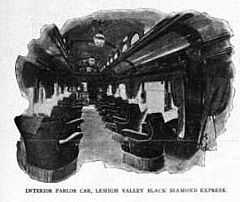Black Diamond (train)
 The Black Diamond Express in 1898.  Interior of a parlor car, circa 1899. |
The Black Diamond was the flagship passenger train of the Lehigh Valley Railroad (LV).[1] It ran from New York to Buffalo[1] from 1896 until 1959, when the Lehigh Valley's passenger service was reduced to four mainline trains.[2]
History
Service between Jersey City, New Jersey and Buffalo began on 18 May 1896,[3] It originally used the Pennsylvania Railroad's Exchange Place Station, where passengers could board ferries to station to New York.[3] In 1913, the train was forced by the PRR to vacate the station so the eastern terminus was changed to the Central Railroad of New Jersey's Communipaw Terminal.[3] That lasted only five years, as the United States Railroad Administration decided in 1918 to re-route all Lehigh Valley trains into New York Penn Station to centralize traffic.[3] For most of its existence the Black Diamond used the Lehigh Valley Terminal in Buffalo.
The Black Diamond competed with services offered by the Delaware, Lackawanna and Western Railroad and the New York Central Railroad; although slower than either of these, its level of service won it the nicknames "the Handsomest Train in the World" and "the Honeymoon Express."[4] In 1940 the train was provided with the line's first set of lightweight streamlined coaches, designed by Otto Kuhler, who also designed streamlined shroudings for the existing 4-6-2 Pacific locomotives that hauled the train.[1] Later, the Pacific engine was replaced by Alco's PA-1, which was painted Cornell red with black playing a secondary role.[1] The black was used in a role similar to the "cat whiskers" that appeared on the PRR's GG-1's.[1]
The train's last run was on 12 May 1959,[5] due to widespread cuts to all Lehigh Valley passenger service.[1][2] All passenger service ended on February 3, 1961.[6]
Origin of Name
The train was named for the railroad's major cargo, anthracite coal, which was known as "the black diamond" because of its exceptional hardness and high value. As a result, the railroad used "The Route of the Black Diamond" as its slogan.[1]
Miscellaneous
The Lehigh Valley Railroad also operated trains #28 and #29 (the John Wilkes) which also boasted Otto Kuhler designed streamlining shrouds very similar in design to the Black Diamond.[1]
Sources
- "The 'Black Diamond' on the Lehigh". Railway and Locomotive Engineering (New York: Angus Sinclair Co.) 20 (12): 525–526. December 1907.
- Fisher, Charles E. (1921). "America's Most Famous Trains". Railroad History (Railway & Locomotive Historical Society): 24–26. A Reprint of Bulletins No. 1 and 2.
- Archer, Robert (1977). The Lehigh Valley Railroad, The Route of the Black Diamond. Berkeley, CA: Howell-North Books. p. 372. ISBN 0-8310-7113-3.
- Schafer, Mike (2000). More Classic American Railroads. Osceola, WI: MBI. ISBN 076030758X. OCLC 44089438.
References
| Wikimedia Commons has media related to Black Diamond (train). |
- ↑ 1.0 1.1 1.2 1.3 1.4 1.5 1.6 1.7 "The Black Diamond, The Lehigh Valley Railroad's Flaghip Passenger Train". American-Rails.com. 2007-2008. Retrieved 2008-08-26.
- ↑ 2.0 2.1 "One Buffalo, One N.Y. Run". Geneva Times. 1959. Retrieved 2008-08-27.
- ↑ 3.0 3.1 3.2 3.3 "The Black Diamond (LV)". New Jersey Railroad Information. Retrieved 2008-08-28.
- ↑ Schafer (2000), 77.
- ↑ "Timeline, 1942-1966". Village of Manchester. Retrieved 2008-08-26.
- ↑ "Last of the Railroad - Era Passes Tonight as Lehigh Ends Service". Geneva Times. 1961. Retrieved 2008-08-27.